Online evaluations are incredibly influential in today’s digitally linked world when it comes to influencing a company’s reputation and luring new clients. Facebook has distinguished itself as a powerful participant in the social proof field among the many available platforms. Facebook Business Page Reviews, frequently referred to as electronic “word-of-mouth,” have a big impact on a company’s success and reputation. Customer reviews on one’s Facebook page have a big impact on their trustworthiness and reputation. They assist potential clients in making educated judgments by attesting to the caliber of their goods or services.
To get Facebook Business Page Reviews, here are the 17 ways to follow.
- Activate Facebook Page Reviews: The first step is to check that the review tool is active on the Page, allowing users to offer feedback.
- Create a Facebook Post Requesting Reviews: Post requests on a regular basis, urging satisfied consumers to share their experiences and submit reviews on the Page.
- Embed Facebook Reviews on Your Site: Display positive reviews straight on the website for future clients to see.
- Incorporate a Facebook Review Widget: Use third-party review widgets to display Facebook reviews on the website prominently.
- Ask for Reviews via Facebook Messenger: Engage with clients via Messenger and gently ask for reviews following a positive interaction.
- Respond to Comments and Queries from Followers: Engaging the public actively builds trust and encourages additional reviews.
- Turn on Notifications for New Reviews: Stay informed about new reviews and respond to them to demonstrate dedication to customer satisfaction.
- Collect In-Person Reviews: Encourage clients to post reviews on their smartphones while they are there if a business has a physical location.
- Promote Facebook Page on Other Social Platforms: Cross-promote the Facebook Page on other social media platforms to increase its reach and review count.
- Send Email Invitations to New Buyers: Send automatic email invitations asking for comments and reviews after a purchase.
- Provide Discounts and Incentives: Provide discounts or incentives to customers who submit reviews to encourage them to share their experiences.
- Reply to Negative Reviews: Address negative reviews professionally and rectify issues to demonstrate a commitment to client pleasure.
- Inspire Facebook Check-Ins: Encourage clients to check in at the business’s location, which leads to them leaving a review.
- Request Feedback Through SMS Messages: Use an easy link to send SMS messages to prior customers requesting feedback and reviews.
- Highlight Exceptional Reviews on Facebook: Share outstanding reviews as posts on the Page to demonstrate the company’s commitment to providing excellent service.
- Include a Call To Action (CTA) Button for Reviews: Make it easy for customers to offer feedback by including a “Review” or “Recommend” button prominently on the home page.
- Integrate ‘Leave Us a Review’ Buttons on Your Site: Place review buttons strategically on the website so that people navigate the company’s Facebook Page and post evaluations.
1. Activate Facebook Page Reviews
Activating Facebook Page Reviews is the act of enabling the feature that allows customers and visitors to the Facebook Business Page to submit reviews and share feedback about the company’s products or services.
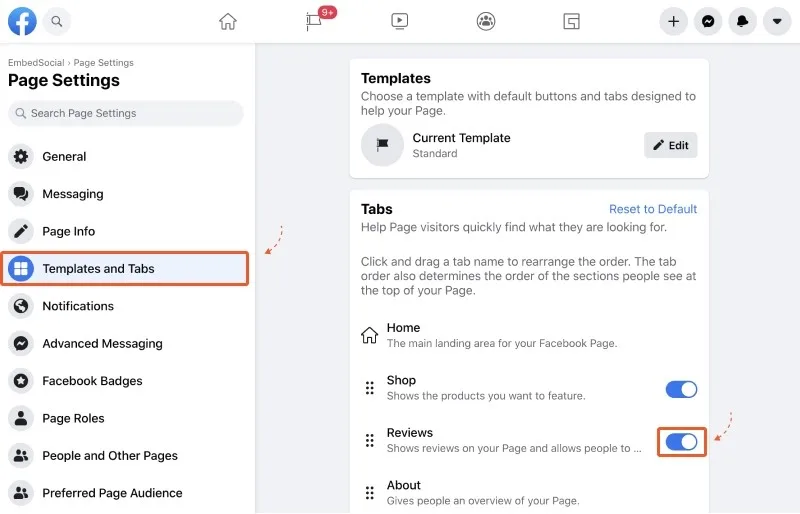
Start by authenticating into the Facebook account and navigating to the business Page to activate Facebook Page Reviews. Second, select the “Settings” tab located in the upper-right corner of the Page to access the Page settings. Select “General” from the left-hand menu and scroll down to the “Country Restrictions” area to ensure no restrictions on who is allowed to submit reviews. Third, navigate to the “Reviews” area and select “Edit” or “Settings.” One has the option to turn reviews on or off in the review section. Activate reviews by checking the box labeled “Allow visitors to review the Page.” Remember to save the changes so the customers and visitors see Facebook Page Reviews.
Activating Facebook Page Reviews is extremely beneficial since it creates a route for customers to express their experiences, which influences new purchasers. Reviews give social proof and foster confidence, making one’s company appear more trustworthy and genuine.
Activating Facebook Page Reviews helps business owners display good feedback, communicate with customers, and boost their online reputation. Activating Facebook Page Reviews helps increase the visibility of the Page in search results and attract more clients.
There is an overwhelming majority of positive reviews, but there are negative reviews. Negative criticism must be handled professionally and swiftly, as ignoring or mishandling it undermines the company’s reputation. One receives spammy or irrelevant reviews, which is difficult to handle. These disadvantages are avoided with adequate review management procedures.
2. Create a Facebook Post Requesting Reviews
A Facebook Post Requesting Reviews is a social media approach used by businesses to encourage their Facebook followers and customers to contribute their opinions and experiences. A Facebook Post Requesting Reviews entails creating a well-structured post on a Facebook Business Page that specifically requests reviews and provides detailed directions on how to leave them.
Begin by writing a compelling post expressing gratitude for the consumer’s support before creating a Facebook Post Requesting Reviews. Make it clear that businesses want reviews and give them step-by-step directions on how to write one, such as sending them to the “Reviews” tab, clicking “Write a Review,” and sharing their ideas. Adding images and a Call to Action (CTA) button or link improves the content and speeds up the process. Maintain a professional and upbeat tone throughout, emphasizing the importance of candid feedback.
Facebook Post Requesting Reviews is a powerful tool for gathering client feedback. The effectiveness of a Facebook Post Requesting Reviews is determined by the company’s interaction with its target audience and the quality of its products or services. Facebook Post Requesting Reviews produces a consistent stream of reviews when done effectively, which helps in establishing credibility and trust.
There are various advantages to using Facebook Post Requesting Reviews. Facebook Post Requesting Reviews enables direct interaction with the audience, which fosters a sense of connection and loyalty. The exposure of the post reaches a large audience, boosting the opportunity for various reviews. Clear instructions make the review process easier, which encourages more consumers to offer feedback. Facebook Post Requesting Reviews adds a human touch, demonstrating real respect for consumer feedback and developing relationships.
Facebook Post Requesting Reviews has several downsides. The effectiveness is determined by the number of followers and level of engagement, which limit the number of reviews obtained. Negative feedback is posted, requiring careful monitoring and replies to retain a positive reputation. Excessive use of review requests irritates followers and overwhelms other content, emphasizing the significance of a balanced approach.
3. Embed Facebook Reviews on Your Site
Embedding Facebook Reviews on the website entails adding a section or widget to the website that shows reviews from the Facebook Business Page. Embedding Facebook Reviews on the website enables website users to view customer comments and testimonials shared on the Facebook Page without leaving the company’s site.
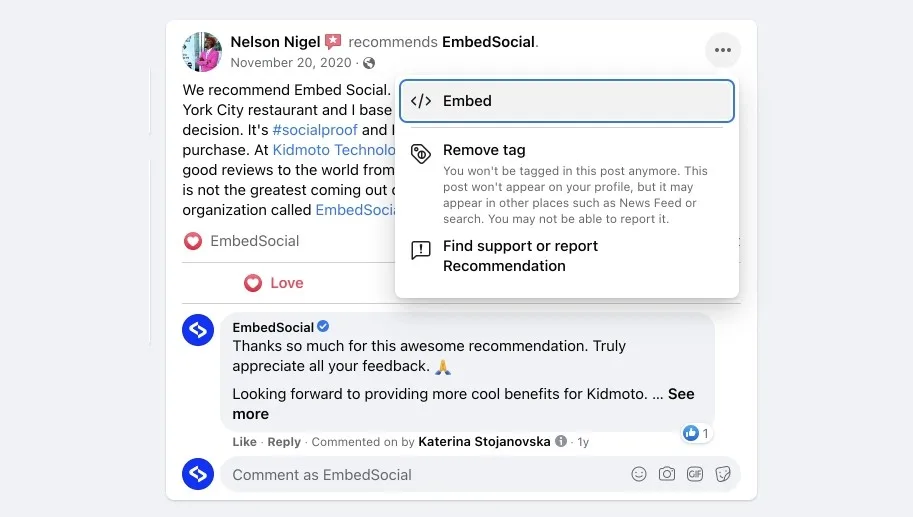
Start by visiting one’s Facebook Page and selecting the “Settings” option to incorporate Facebook Reviews on the website. Locate the “Reviews” tab by choosing “Templates and Tabs” from the left-hand menu afterward. Toggle the switch to “Show Reviews” enabled by selecting “Settings” from the menu. Businesses personalize the tab name and change the review parameters to suit their tastes. Ensure that one saves the changes after configuring these settings.
Businesses proceed to embed the reviews widget on their website once the reviews tab on their Facebook page has been enabled. Open the Facebook Page and select the “Reviews” tab from within it. An option with the label “Embed Reviews” is found on the right side of the page. Select “Embed Reviews” to generate the required HTML code. The HTML source code of the website must contain the provided code, which businesses must copy and paste where they want the reviews to appear. Save and update the website to verify that the embedded Facebook Reviews are visible to the site’s visitors.
Building credibility and trust with prospective customers through integrating Facebook reviews on the website is quite beneficial. Facebook reviews enable consumers to view genuine testimonials from actual customers, which affects their purchasing choices and raises the conversion rate of their website.
There are many benefits to including Facebook reviews on a website. First, Facebook reviews boost the company’s legitimacy and authenticity by displaying real consumer comments. Conversion rates rise as a result of positive reviews in particular because they inspire confidence in potential customers and motivate them to interact with the company’s goods or services.
Facebook reviews feature encourages user interaction by removing the need for users to switch between external social media networks so they have immediate interaction with customers and read reviews on the website. Integrating Facebook Reviews provides SEO benefits, as user-generated content, including reviews, positively impacts one’s website’s search engine ranking.
Embedding Facebook Reviews on the website has some disadvantages to consider. Positive ratings increase trustworthiness, but doing so makes unfavorable reviews prominent. Responding to critical comments professionally and openly assists in lessening and converting such a problem into an avenue for progress. Maintenance is another factor to consider. Keeping the embedded widget updated requires recurring inspections and corrections to guarantee proper operation. The widget’s implementation affects the load time of the website, which has an adverse effect on user experience if not correctly optimized.
4. Incorporate a Facebook Review Widget
Incorporating a Facebook Review Widget entails adding a customized plugin or code snippet to the company’s website that shows their Facebook Page Reviews directly on their site. Facebook Review Widget improves user experience and increases online authority by enabling visitors to read and engage with reviews without leaving their website.

Businesses adhere to these guidelines to add a Facebook Review Widget. Go to the Facebook Page and select the “Settings” option first. Pick “Templates and Tabs” from the left-hand menu. Find “Reviews” by scrolling down and clicking on it. Select “Show Reviews” from the menu, then click “Save.” Next, go to the Facebook Developers website and use the “Facebook Page Plugin” tool. Enter the URL of the company’s Facebook page to configure the plugin’s width, height, and displayed tabs. Click “Get Code” to retrieve the HTML code snippet after customizing the widget as desired. Business web developers must insert the code wherever on the company’s website they want the widget to display in the HTML. Ensure the website embeds HTML, or ask the company’s web developer for help.
The legitimacy and dependability of the company are effectively communicated to website visitors by incorporating a Facebook Review Widget. Facebook Review Widget simplifies the review access procedure by allowing visitors to see and leave reviews without leaving the site. More interactions and a better user experience result from such convenience.
One of the main benefits of utilizing a Facebook Review Widget is that it offers users a simple way to access and interact with reviews on the website. Facebook reviews increase confidence among potential customers by featuring genuine user-generated material directly on the website. Positive reviews that are prominently displayed on the website act as powerful social proof, increasing conversions and queries. Facebook Review Widget is editable, so businesses modify its appearance to fit the style of their website.
A Facebook Review Widget has a lot of advantages, but it’s essential to consider any disadvantages. One significant drawback is that it solely displays Facebook reviews, leaving out feedback from other networks. Businesses must add more widgets or solutions if the company has reviews on several sites. Some visitors wonder about the integrity of the reviews posted on one’s website since they wonder if they have been carefully chosen. Promoting open communication and a range of opinions is essential to alleviate such concerns. The widget’s user experience and overall effectiveness are affected by bad widget implementation, such as erroneous coding or poor design integration. It is vital to guarantee correct installation and upkeep.
5. Ask for Reviews via Facebook Messenger
Asking for reviews via Facebook Messenger entails contacting the customers directly through the social network’s chat system and soliciting their opinions about the business, its goods, or services.
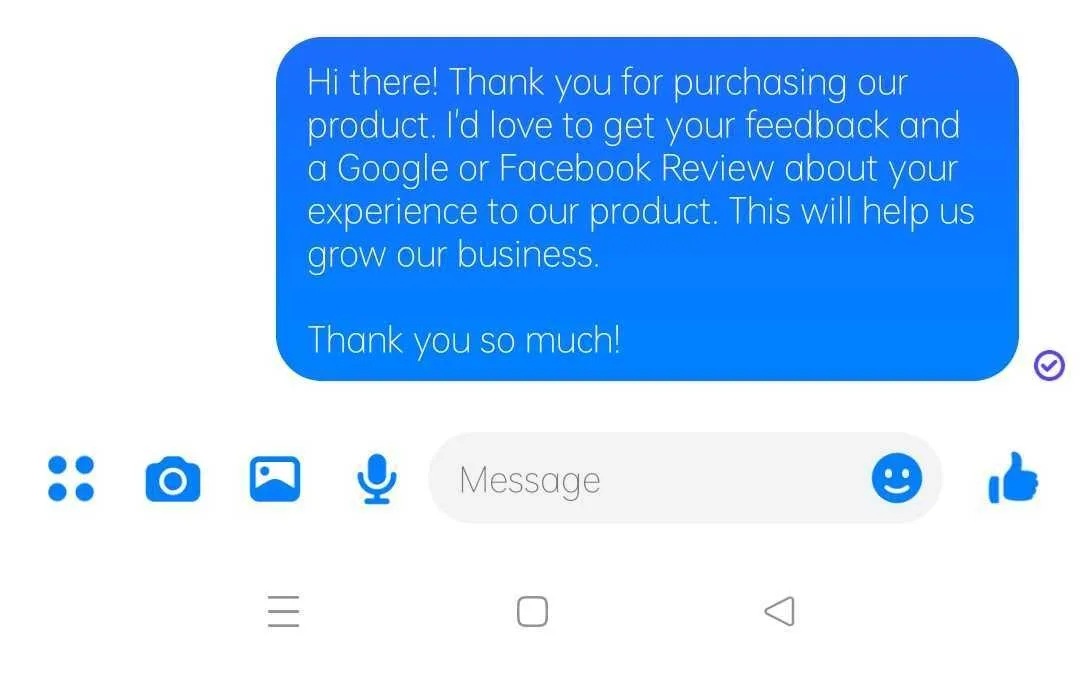
Identifying pleased clients or customers who have recently connected with the company helps the business ask for reviews via Facebook Messenger. Create a customized message to thank them for their business and kindly ask if they are willing to post their comments about their experience on the company’s Facebook Page. Provide the customers with a direct link to the review section of the company’s Facebook Page to make the process as simple as feasible. Remember to maintain a polite and non-intrusive tone throughout the talk.
Requesting feedback using Facebook Messenger is beneficial because it allows for direct and individualized customer engagement. People leave evaluations when approached individually, as it feels closer to a personal request than a mass message.
There are various benefits to requesting reviews over Facebook Messenger. First, requesting reviews offers a personalized method of client contact, highlighting the value of their feedback and sincere interest in it. Customers feel more connected to a business when it takes the time to get to know them, encouraging them to submit evaluations. Second, individualized requests for reviews have a greater conversion rate than generic, mass requests for reviews. Third, making it easy for customers to access the review part of the Facebook Page makes it easier to predict that they are going to spend the time to do so.
There are several negatives to consider. Asking for reviews via Facebook Messenger involves a lot of effort because each message needs to be given particular attention, especially if businesses have a considerable customer base. Specific customers view unsolicited messages as an invasion of their privacy or an intrusion, resulting in unpleasant reactions. Customers who refrain from posting reviews reject business or respond negatively, resulting in unpleasant interactions. It is essential to be aware of and follow Facebook’s policies surrounding using Messenger for business reasons, as violations result in limitations or penalties.
6. Respond to Comments and Queries from Followers
Responding to comments and queries from Facebook Business Page followers entails engaging with the audience by addressing their comments, questions, and concerns. The company’s dedication to client satisfaction and community involvement is evident from such engaged contact.
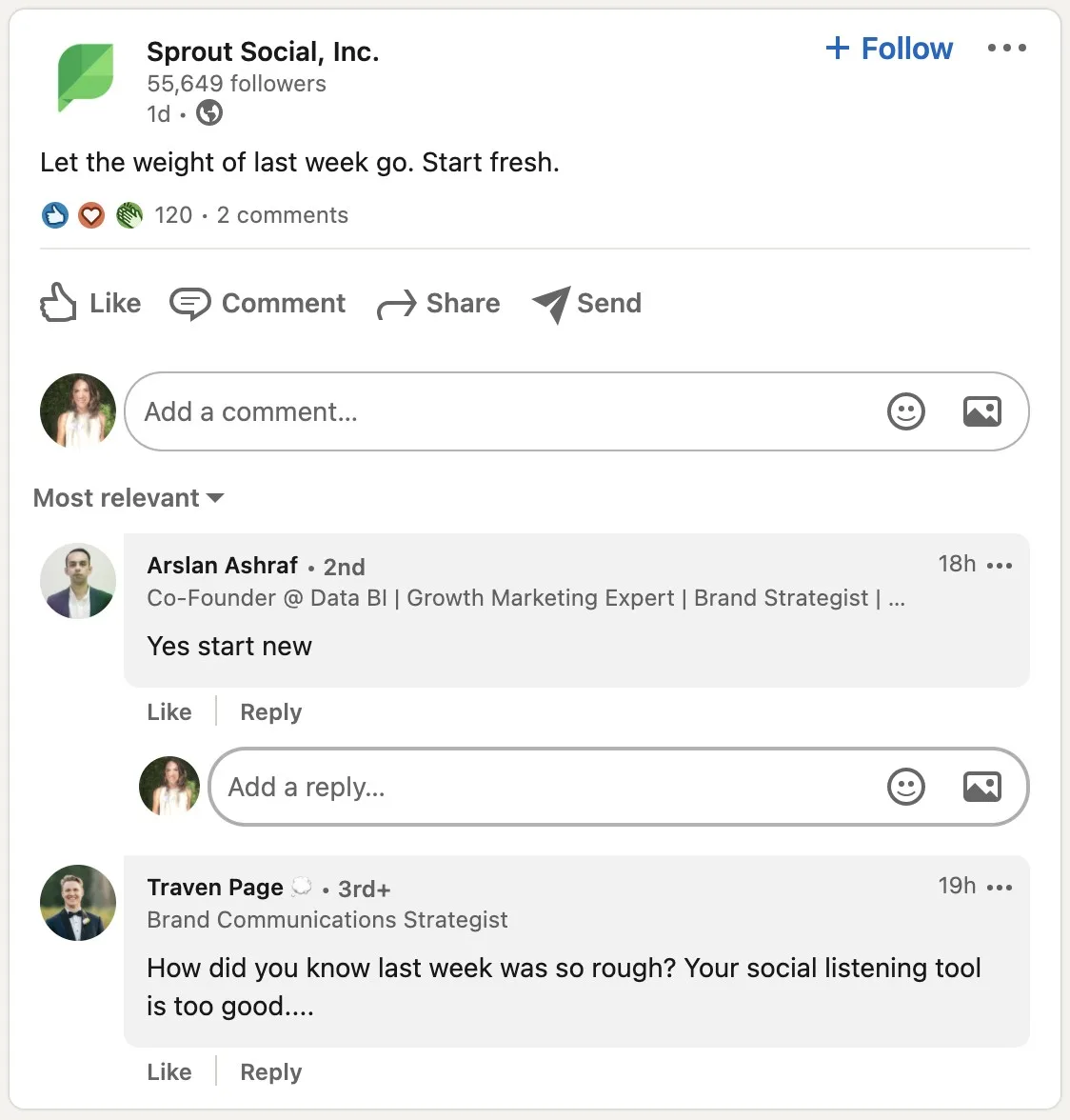
Followers often post questions and comments, so make sure to keep an eye out for them on the Facebook page. Page moderators must respond to comments and queries as soon as they see them politely and promptly. Address any questions or concerns, offer useful details, and appreciate favorable comments. Ensure the responses are precise, concise, and consistent with the voice and messaging of the company.
Building a strong online presence involves responding to followers’ comments and inquiries. Responding to followers encourages a sense of community, demonstrates attentiveness, and boosts client loyalty. More people give reviews and join in discussions on the Page if companies interact with their audience.
There are many benefits to responding to questions and comments on one’s Facebook business page. First, responding to them increases consumer involvement, demonstrating the company’s commitment to client happiness and enhancing the reputation of the brand. Responding to them strengthens the company’s ties with customers and encourages advocacy among the followers. Continuously responding to comments and inquiries promotes a strong brand image by demonstrating the company’s dedication to customers’ thoughts and experiences. Active followers are inclined to produce user-generated content to help companies advertise their company.
Responding to comments and queries has disadvantages. Responding to comments and queries takes a lot of time, especially for Pages with a big following or many interactions. Negative feedback must be handled delicately and is difficult because doing so harms the company’s reputation. The demand for resources such as workforce arises when the company’s Page’s interactions develop. The risk of miscommunication in written communication highlights the significance of providing clear responses and preventing misconceptions.
7. Turn On Notifications for New Reviews
Turning on notifications for new reviews on one’s Facebook Business Page entails updating the Page’s settings to get alerts whenever a user posts a new review. Companies receive these notifications in various ways, including email or the Facebook Page admin interface, ensuring they are always updated on user comments.
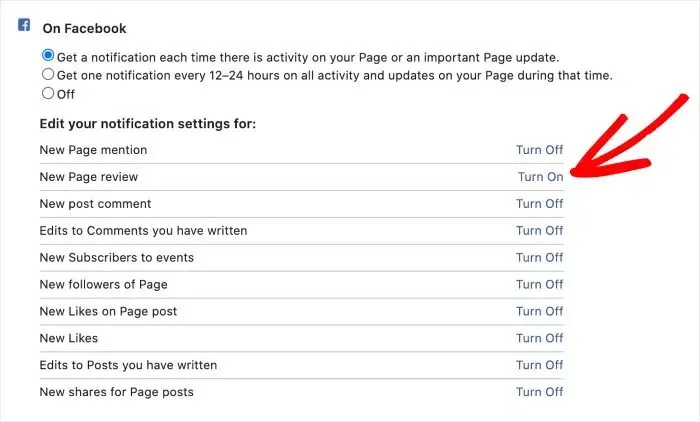
Start by signing in to the Facebook Business Page and going to the settings page to enable notifications for new reviews and choose “Notifications.” One finds an option to sign up for notifications whenever someone writes a review on the Page in the “Review” area. Turning on the feature further personalizes the notification choices, such as selecting whether to get alerts by email or as in-app notifications on the Facebook Page Manager dashboard. Companies get alerts when a new review is posted once they save the changes.
Turning on notifications for new reviews is quite beneficial because it allows companies to stay current with consumer feedback in real-time. They must respond quickly to positive and negative reviews due to the proactive approach, which shows the company’s dedication to ensuring client happiness.
There are various benefits to enabling new review alerts on the Facebook business page. Turning notifications on allows prompt responses to favorable and unfavorable comments, highlighting the company’s dedication to ensuring client pleasure. Regularly checking client reviews shows that the company values their feedback, leading to greater engagement and loyalty. It helps companies manage and highlight the best reviews while responding to unfavorable remarks, which is helpful for reputation management. Responses to reviews favorably affect potential customers’ impressions and insights from reviews help to improve the quality of a product or service.
There are some drawbacks to consider. Many evaluations for the company make managing notifications difficult and time-consuming. Email notifications raise privacy issues because they reveal the company’s personal email address, which some users find objectionable. Relying solely on alerts results in missing reviews due to technical difficulties or notifications that become buried in the email or Facebook management interface. There are few choices for detailed and filtered customization of notifications. It is resource-intensive to continuously monitor and reply to evaluations, especially for small organizations with few employees.
8. Collect In-Person Reviews
Collecting in-person reviews entails aggressively seeking out comments and reviews from clients who physically visit the place of business. Collecting in-person reviews encourages clients to talk about their interactions with the company’s goods or services right away.

Start by teaching the staff to respectfully ask consumers for feedback at the point of sale or after their visit to gather in-person reviews properly. Give them instructions on how to request reviews, highlighting the value of candid criticism. Businesses design visually appealing review cards or booklets that conveniently include QR codes or direct links to the company’s Facebook Page. Consider establishing dedicated review stations on the physical site where customers get to provide feedback using their mobile devices.
Collecting in-person reviews is extremely helpful since it gets quick input from clients who have just experienced the goods or services. Customers clearly recall their experiences, so reviews are expected to be more genuine and in-depth. The technique improves the overall customer experience by demonstrating that the company values their feedback.
One key advantage of collecting in-person reviews is that it allows for better response rates. Customers who are satisfied or dissatisfied with their experience are more inclined to communicate their thoughts when asked in person. Customers believe that the business cares about their feedback if they collect in-person reviews, which helps build trust. In-person reviews are particularly beneficial for service-based organizations or businesses with actual stores because they provide direct insight into client opinion.
Collecting in-person reviews has some disadvantages. Some consumers are sometimes uncomfortable giving their thoughts in person, which skews the feedback businesses get. The format and scheduling of in-person reviews vary widely, making managing and recording them consistently challenging. The effectiveness of collecting in-person reviews depends on the caliber and reliability of the company’s staff’s customer contacts, which takes time to manage.
9. Promote the Facebook Page on Other Social Platforms
Promoting the company’s Facebook Page on other social platforms entails taking advantage of the reach and audience of platforms such as Instagram, Twitter, LinkedIn, and other relevant social media networks to raise awareness about the Facebook Business Page.

Create interesting updates or information appropriate for each social media network before promoting one’s Facebook Page there. Share eye-catching updates, pictures, videos, and links to get new followers for the Facebook page from the current fans. For example, the company uses Twitter to create tweets that include a link to one’s Facebook Page and a clear call to action (CTA). Share visually engaging Instagram posts with captions pointing people to the Facebook Page. Consider using paid advertising on these networks to reach a larger audience. Users are directed to the company’s Facebook Page by customized advertisements they generate.
Promoting the company’s Facebook page on additional social networks is a highly efficient way to grow its fan base and make its page more visible. Promoting the company’s Facebook Page on other social platforms allows the company to tap into the networks of its current followers, perhaps drawing in people who have not found the Facebook Page otherwise but are interested in its goods or services.
There are many benefits to promoting one’s Facebook page on other social networks. First, promoting the company’s Facebook Page on other social platforms makes content more visible, which attracts more likes, follows, and future reviewers. Second, it makes marketing easier to certain demographics and interests, ensuring that the right people hear the company’s message. Third, cross-promotion improves the company’s internet visibility and upholds brand coherence.
There are disadvantages to consider in promoting the company’s Facebook Page on other social platforms. Promoting the company’s Facebook Page on other social platforms takes a lot of energy, time, and extra resources to manage various platforms. Creating platform-specific content is essential due to differences in user behavior and best practices. Intense competition from competing firms on these platforms necessitates the purchase of sponsored advertising to stand out.
10. Send Email Invitations to New Buyers
Sending email invitations to new buyers entails contacting existing clients and asking them for reviews of the business on social media sites such as Facebook. Sending email invitations to new buyers takes advantage of email’s practicality to get in touch with recent clients and solicit their feedback.
Follow the steps to implement the technique successfully. Obtain a customer’s email address once they’ve made a transaction with their permission. Send a personalized email to thank them for their purchase and gently ask for feedback on the company’s goods or services within a fair amount of time, usually a few days to a week following the sale. Make it simple for them to post a review by including a direct link to the Facebook page or the relevant review section. Avoid pressure techniques in the email and keep it brief, clear, and respectful.
Requesting reviews from new customers via email is very successful. Recent customers are more inclined to leave feedback because their interaction with the company is still fresh in their memories. Emails provide a direct and practical method for communication, improving the rate of response.
Sending email invitations to new buyers has several benefits. Sending email invitations to new buyers specifically targets recent purchasers, who are more inclined to post favorable ratings. Emails add a personal touch, increasing the rate at which customers engage. The company decides when to make the request, ensuring it matches the customer’s experience. Customers’ review-writing experience is made simpler by offering a direct link, boosting their rate of leaving a review.
Sending email invitations to new buyers has certain downsides despite its efficacy. Customers regard review requests as intrusive or spammy, which results in bad feedback or email unsubscription from businesses. It is important to send the email promptly, or customers don’t have enough time to review the goods or services. Not all customers read or reply to the company’s email, which further restricts the effectiveness of these tactics. A properly managed email list and compliance with data protection rules, including GDPR or CAN-SPAM, are necessary to avoid legal issues.
11. Provide Discounts and Incentives
Providing discounts and incentives as a strategy to gather Facebook Business Page Reviews involves offering special promotions, discounts, or rewards to customers in exchange for their honest feedback and reviews on the page.

Making a compelling offer that appeals to the target audience is the first step in successfully implementing discounts and incentives. The offer is a discount on their subsequent purchase, a free gift, or a chance to win something. Next, let the customers know about the offer through multiple methods, including email, social media posts, or face-to-face contacts. Businesses must encourage customers to post a review on the Facebook page once they’ve used the product or service. Provide the agreed-upon discount or incentive right away after they’ve placed their review to keep the commitment. Make the procedure easier for the customers to enjoy.
Discounts and incentives are powerful for obtaining Facebook Business Page Reviews. Customers are inclined to post evaluations since it provides them with an immediate perk for taking the time to express their feedback. The strategy frequently yields a bigger volume of evaluations, which enhances the company’s online reputation and positively impacts future clients.
Providing discounts and incentives in exchange for Facebook Business Page reviews has many benefits. The discounts and incentives greatly enhance the quantity of reviews, raising the social proof of the excellence of the company. Providing discounts and incentives encourages consumer interaction by highlighting the company’s appreciation for their feedback and willingness to reward it. The strategy increases sales because buyers are more likely to buy something to take advantage of the promotion. More reviews help the company gain trust and improve its reputation online.
Providing discounts and incentives has some significant drawbacks. Customers tend to submit positive evaluations to get rewards, which increases the rate of biased reviews. Offering bonuses or discounts has an impact on the company’s profit margins, so cost-effectiveness must be carefully considered. Reviews that are given incentives are not always favorable. Unpleasant comments appear and require expert management. Maintaining the strategy over the long term is difficult if the expense of incentives starts to weigh heavily on the company.
12. Reply to Negative Reviews
Replying to negative reviews is the process of contacting and interacting with clients who have complained about the company’s goods or services in online reviews, such as customers posted on the Facebook Business Page.

Start by acknowledging the customer’s issues and demonstrating empathy for their experience to reply to unfavorable reviews effectively. Refrain from being aggressive or defensive. Provide a remedy or resolution to their problem, whether it entails immediately fixing it, extending a refund, or offering more assistance. Encourage future discussion through private channels, such as direct messages or email, by keeping the response concise and formal. Always keep the tone upbeat and customer-focused when responding.
Several strategies for responding to bad reviews are very successful. Replying to negative reviews demonstrates the company’s dedication to client pleasure and assists in converting an unhappy client into a devoted one. The company improves the reputation of its brand by being transparent and accountable by publicly addressing problems. Replying to unfavorable reviews allows them to get insightful criticism, spot areas for improvement, and implement the necessary modifications to better their goods or services.
There is a benefit to responding to bad reviews. Replying to negative reviews helps to retain customers by fixing concerns and turning unpleasant encounters into positive ones. Addressing issues in the open shows that they care about client satisfaction and improve their online reputation. Negative reviews frequently provide useful insight for improvement, and being open and honest with reviewers and future customers fosters confidence.
There are disadvantages to consider in replying to negative reviews. Responding to unfavorable reviews takes time, especially if there are many to manage, and constant platform monitoring is required. There is an opportunity for difficulties to escalate since unsatisfied reviewers are not happy with the company’s solution, which results in further critical remarks or escalating situations. Errors or misunderstandings are devastating when responding to negative reviews in a public area where everyone sees them. It is stressful for people responsible for managing negative feedback to have to deal with it regularly.
13. Inspire Facebook Check-Ins
Encourage customers and guests to post their current location on Facebook when they visit the company site or event to encourage Facebook check-ins. Encouraging customers for Facebook check-ins results in postings being created on their own timelines or the company page, which raises visibility and reaches a larger audience.
Create an attractive and memorable experience at the physical site to encourage Facebook check-ins. Ensure the company’s staff is welcoming and helpful, and consider providing something extra to guests who check in, such as discounts, special offers, or the opportunity to participate in a contest. Encourage clients to check in by posting signage, presenting the Facebook Page URL, or encouraging them personally. Run promotions or competitions on the Facebook page, where entry requires a check-in, to motivate users to interact.
The visibility and trustworthiness of the company are raised by encouraging Facebook check-ins. The social side of Facebook is tapped into because friends and connections view check-ins, reaching a larger audience. Check-in users are effectively recommending the company to their social networks, which improves foot traffic and online engagement.
Encouragement of Facebook check-ins has several benefits, such as better online visibility through the clients’ social networks, increased trust and credibility because of positive endorsements, the production of user-generated content for marketing purposes, and a way to increase foot traffic and loyalty through incentives.
Inspiring Facebook check-ins come with drawbacks for some customers, including privacy concerns, fluctuation in effectiveness based on user activity and willingness, the need for ongoing maintenance to keep the rewards coming, and the risk of bad reviews if the customer experience is subpar. The implementation of a Facebook check-in strategy necessitates careful consideration of these pros and cons.
14. Request Feedback Through SMS Messages
Requesting feedback through SMS messages entails sending text messages to the consumers or clients to solicit their opinions, evaluations, or remarks regarding their experience with the company. The approach gives the company the opportunity to interact with its audience directly through their mobile devices, offering a quick and easy way to get feedback.

Start by building a list of the clients’ phone numbers with their permission to receive such messages if the company wants to ask for feedback via SMS. Create a brief, courteous message outlining the company’s desire to collect feedback and a link to the Facebook business page or a specific review site. Make sure the message is understandable, discrete, and privacy-preserving. Schedule the SMS to be sent at the right time once the message is prepared, such as after a consumer interacts with the business. Customers must be urged to use the offered link to provide feedback.
The efficiency of requesting feedback via SMS texts varies based on the audience and the time of the company’s communications. Requesting feedback through SMS messages is a very successful strategy, especially if the companies have a consumer base that favors text-based communication. It provides a quick and direct approach to getting input, resulting in a higher response rate than other channels.
SMS message feedback requests have several benefits. First, requesting feedback through SMS messages enables prompt responses by providing direct consumer communication. Second, it’s practical because most people carry their smartphones, enabling feedback while on the road. Third, it makes timely feedback gathering easier, particularly following exchanges. Fourth, SMS messages frequently have high open rates, boosting the rate at which customers receive and reply to requests for feedback.
There are disadvantages to requesting feedback through SMS messages. Customers who have not chosen to receive these messages are put off by privacy concerns. Character constraints on SMS texts prevent detailed feedback. There is a spam risk if not effectively managed, which annoys customers. The representativeness of the input gathered is affected by the broad variations in response rates.
15. Highlight Exceptional Reviews on Facebook
Highlighting exceptional reviews on Facebook entails prominently highlighting and showcasing exceptionally great and notable consumer comments on the Facebook Business Page. Exceptional reviews frequently include eloquent praise, excellent ratings, or particular compliments from delighted clients.

Start by finding the reviews that stand out owing to their extraordinary praise or in-depth favorable feedback if the company wants to promote exceptional reviews on Facebook. The companies pin exceptional reviews to the top of their Facebook Business Page’s Reviews section once they have located them. Choose “Pin to Top” from the menu that appears when clicking on the ellipsis symbol on the right side of the review. Page moderators make articles or visuals highlighting exceptional reviews, promoting them to the followers, and boosting interaction. Consider sending exceptional reviews and customized letters of appreciation, emphasizing their worth even more.
Highlighting exceptional reviews on Facebook has the power to win over new clients’ confidence and trustworthiness. Exceptional reviews are potent social proof of the excellence and customer happiness of the company’s goods and services. They persuade prospects to choose the company over rivals by positively influencing their decisions.
Highlighting exceptional reviews on Facebook provides advantages. Highlighting exceptional reviews on Facebook increases credibility and trust by offering strong recommendations, which improve the company’s reputation and encourage trust among future customers. Exceptional reviews strengthen the brand image by demonstrating the company’s dedication to quality and client happiness. Exceptional reviews affect consumer choices, thereby increasing sales and revenue. Engaging with exceptional reviews gives the company the opportunity to have meaningful conversations with customers, which reinforces their positive experiences.
There are certain disadvantages to consider. Exceptional evaluations are few, making it difficult to emphasize them regularly. The perception of bias and lack of transparency are created by concentrating on exceptional reviews, especially if unfavorable feedback is disregarded. The method’s long-term viability becomes problematic, especially as the number of reviews rises. Consistently displaying exceptional reviews has the ability to raise expectations, which leaves customers disappointed if subsequent experiences fall short of their high expectations.
16. Include a Call To Action (CTA) Button for Reviews
Including a Call To Action (CTA) button for reviews on the Facebook page is a smart move to encourage and direct visitors to the Page to actively share their experiences with the company through reviews. The Call To Action (CTA) button stands out strongly on the company’s Page to nudge visitors to share their comments.
Add a CTA button for reviews on the Facebook page by following the steps. Go to the Page and select the “Settings” option first. Go to the “Templates and Tabs” section next. Make sure the “Reviews” tab is present and turned on. A “Reviews” tab is needed to show up on the Page after it has been activated. The companies add a CTA button, such as “Write a Review,” if they click on “Reviews.” Follow the prompts to customize the button text and link it to the company’s review area after selecting the option.
Incorporating a CTA button for reviews greatly increases user engagement and elicits useful comments. Visitors find the review process more user-friendly, increasing the rate at which they submit reviews. The button’s prominence improves the entire review-gathering strategy by regularly reminding consumers to express their comments.
The usability of a CTA button for reviews is one of its many significant benefits. The CTA button for reviews reduces friction by giving users a clear and direct route to post feedback. Many reviews rise as a result, enhancing the reliability and reputation of the company online. A CTA button for reviews shows that the company is open to criticism and is transparent, which increases customer confidence.
CTA buttons for reviews are usually helpful, but some users find them to be intrusive or demanding. Striking a balance between soliciting reviews and honoring their audience’s sovereignty is essential. Focusing on overly strong evaluations makes some users feel under pressure, leading to unfavorable comments or decreased participation. It is necessary to utilize CTA buttons wisely and keep the company’s review requests respectful.
17. Integrate ‘Leave Us a Review’ Buttons on Your Site
Integrating “Leave Us a Review” buttons on the website involves placing clickable elements or call-to-action (CTA) buttons in a way that encourages site users to share their opinions about the business on social media sites such as Facebook. Call-to-action (CTA) buttons often link to the review section of the Facebook Business Page, making it simple for customers to share their opinions and experiences on the website.
Create a visually stunning and attention-grabbing CTA button before adding the “Leave Us a Review” button to the site. Text or pictures are used to say things such as “Leave a Review” or “Share Your Experience.” The button must be strategically placed on the website, often on relevant pages, such as the homepage, product pages, or contact pages. Make sure the button is visible so that people find it. Link the button to the review area of the Facebook Page to make the process easier for users. The company places a brief message next to the button asking visitors to share their opinions and experiences.
Integrating the “Leave Us a Review” buttons on the website is a very efficient way to increase the number of Facebook reviews. The buttons simplify the review procedure and minimize the processes users must complete to submit comments. Customers are empowered to share their opinions due to its convenience because they don’t have to leave the website to do so.
There are many benefits to adding “Leave Us a Review” buttons on the website. First, adding the “Leave Us a Review” button simplifies the review procedure, facilitating visitor comments and raising the opportunity of receiving reviews. Second, the “Leave Us a Review” button directs visitors to the review part of the Facebook Page so they know exactly where to provide feedback. Third, gathering more favorable evaluations greatly improves the company’s internet credibility and reputation, drawing in a more extensive consumer base.
There are some limitations to consider in integrating the “Leave Us a Review” buttons on the website. Integrating the “Leave Us a Review” buttons on the website does not inspire reviews on other platforms as it primarily concerns obtaining Facebook reviews. The company must use additional tactics if it wants reviews from several websites. The website traffic the company’s site receives affects how effective the strategy is. The “Leave Us a Review” button doesn’t have much impact if the website gets a small amount of traffic. The review button becomes less noticeable among other elements on the company’s website if it has several calls to action (CTAs), which lessens its efficacy.
What are Facebook Business Page Reviews?
Facebook Business Page Reviews are comments and ratings submitted by customers and website visitors on a company’s Facebook Page. People have a platform to express their ideas and experiences regarding a specific company, good, or service due to customer reviews. Reviews frequently include written remarks and a star rating, which is usually assigned on a scale of 1 to 5, with 1 being the lowest rating and 5 denoting the highest.
Facebook Business Page Reviews are essential to managing a company’s online presence and reputation. They provide new customers with information about the caliber of the goods or services, customer satisfaction levels, and the company’s overall reliability. Reviews influence new consumers’ decisions, as favorable ratings encourage trust and confidence while negative ones raise questions. Businesses actively seek out and manage reviews to develop a positive internet reputation, draw in new customers, and fix any problems or difficulties that reviewers have. Facebook Business Page Reviews bring additional responsibility and transparency, enabling businesses to interact with their audience and show their dedication to offering top-notch goods or services.
How do Facebook Business Page Reviews work?
Facebook Business Page Reviews work by allowing customers and site visitors to post their thoughts and experiences about a company on its Facebook Page.
The standard procedure for a client or visitor who wishes to post a review is to go to the “Reviews” area of the company’s Facebook Page. They leave a written comment about their experience and rank the company using a star rating system in the last section. Star ratings typically range from 1 to 5. A rating of 1 star denotes a bad experience, while a rating of 5 stars denotes a good one.
A review is published along with the reviewer’s name and profile photo, if they wish to display them, on the company’s Facebook Page after it has been submitted. These reviews are available for others to read, and they mark them as “helpful” or “not helpful.”
The companies have the choice to reply to reviews. Customers’ compliments must be acknowledged, and complaints must be addressed. Businesses interact with their customers through such interactions, demonstrate their dedication to ensuring customer pleasure, and even publicly settle any difficulties.
Customers use Facebook Business Page Reviews as a valuable resource of social proof to make judgments based on the experiences of others. They give companies perceptions of customers’ thoughts, enabling them to modify and enhance their goods and services in response to customer input. Managing and responding to these reviews is essential to keeping a positive online reputation and building trust with the online community.
How to see Reviews on the Facebook Business Page?
To see reviews on a Facebook Business Page, log in to the Facebook account and use the search bar to find the company. Click on the business’s Page after having located it to access it. The “Reviews” tab inside the company Page is usually found in the left-hand menu on desktops or beneath the company name and profile photo on mobile devices.
The “Reviews” tab leads to a page that displays all customer and visitor reviews, loaded with written comments and star ratings that typically range from 1 to 5 stars. The business sorts and filters reviews based on the settings for the Page, making it simpler to find particular feedback. The company interacts with the reviews by designating them as “helpful” or “not helpful” if the Page owner or manager has enabled that option.
Some companies respond to evaluations, demonstrating their dedication to considering customer input. Reading reviews on a Facebook business page is an easy process that allows customers to evaluate other people’s opinions and experiences, assisting in making educated decisions about the products and services offered by the company. The reviews enable companies to interact with their audience and manage their online reputation simultaneously.
Why are Facebook Business Page Reviews important to Businesses?
Facebook Business Page Reviews are important to businesses because they act as a powerful type of social proof. Positive reviews from customers serve as endorsements that greatly impact new consumers’ choices. People are easier to trust and select a company when they perceive that others have had good experiences with its goods or services.
Facebook Business Page Reviews directly impact a company’s online trustworthiness and reputation. Many positive reviews improve a company’s reputation by highlighting its competence and reliability. Negative reviews cause anxiety and deter prospective customers. Companies must actively monitor and respond to evaluations to resolve concerns and demonstrate their dedication to customer happiness.
Facebook Business Page Reviews offer insightful criticism. They connect companies directly to client feedback, enabling them to pinpoint problem areas and decide on product improvements, customer support, and overall strategy. Businesses adapt and change to meet shifting wants and expectations by listening to their customers through online evaluations.
Customer reviews significantly impact a company’s exposure on Facebook. Positive ratings and active user interaction with reviews help a business rank higher in Facebook’s search results, making it more straightforward for prospective customers to find.
Do Facebook Business Page Reviews attract new customers?
Yes, Facebook Business Page Reviews attract new customers. Positive reviews act as recommendations from satisfied consumers, which significantly impact what prospective customers decide. People are inclined to trust and select a company when they perceive that others have had good experiences with its goods or services. Positive reviews offer social evidence that is an effective driver for acquiring new customers.
Companies that actively manage and address reviews show their dedication to enhancing client involvement and happiness. The responsiveness improves the company’s overall reputation and entices new customers to try it because they know their worries or inquiries have been answered.
What is the role of Review Management in Facebook Business Page Reviews?
The role of Review Management in Facebook Business Page Reviews is to determine a company’s online reputation and build customer trust. Review management includes keeping a close eye on, responding to, and planning strategies for evaluations left on a company’s Facebook page.
Review management technique accomplishes several essential goals. Review management helps maintain a good internet reputation by responding to positive and negative feedback. Responding to positive reviews with gratitude strengthens customer loyalty while managing bad reviews with professionalism and empathy shows a dedication to problem-solving, which affects how prospective customers regard the company.
Communicating with customers demonstrates attention to detail and a willingness to act on their feedback. Communicating with customers creates a bond and builds trust, encouraging repeat business and positive word-of-mouth recommendations.
Review management in Facebook Business Page Reviews provides insightful information on the customer’s attitudes, preferences, and problems. Businesses enhance their products, improve services, or change marketing tactics by recognizing recurring themes or problems in evaluations.
Active review management improves a company’s Facebook presence. An organization’s internet visibility is strengthened, and more prospective customers are attracted by active engagement with reviews, including responses.
Maintaining a consistent review management strategy increases credibility and confidence among present and future customers. Review management in Facebook Business Page Reviews exhibits openness, responsibility, and a dedication to providing top-notch goods or services. Review management promotes customer confidence in the company and motivates them to pick it over rivals.
How many reviews do you need on Facebook to get a rating?
There is no set minimum number of reviews needed to receive a rating on Facebook. The reviews a company has gotten are often used to determine its rating. Facebook’s algorithm determines an average rating as users submit reviews and assign star ratings, which range from 1 to 5 stars. The company’s Facebook page shows off its average rating.
The rating changes as more reviews are posted, or existing reviews are updated. A business has a rating shown on its Facebook Page even if there are just a few reviews, which is essential to remember. The ranking reflects customer opinion more accurately as the number of reviews rises.
Is it easy to leave a Review on your Facebook Page?
Yes, it is easy to leave a review on a Facebook Page. People with a Facebook account access the review process because Facebook has made it user-friendly. A user must visit the company’s Facebook page, locate the “Reviews” area, and click on it to submit a review. Customers leave a written review of the company, share their thoughts and experiences, and score it using a star rating of 1 to 5 stars.
Facebook offers consumers clear guidelines and prompts to help them through the review procedure. They have instant access to the review section and leave their opinion. Businesses learn how to get ratings on Facebook by actively engaging with their customers and encouraging them to share their experiences on their Facebook Page.
Businesses encourage customers to leave reviews by soliciting feedback directly, advertising their Facebook page, and offering top-notch goods or services that result in glowing evaluations. Businesses use similar tactics, including putting “Leave Us a Review” buttons on their website or sending email invites to recent clients, to speed up the review procedure and increase the ratings on their Facebook Page.
Does Branding help in getting more reviews on Facebook Business Page?
Yes, branding helps in getting more reviews on a Facebook Business Page. Customers are more inclined to engage with a company and submit reviews if they perceive it to have a solid and distinctive brand identity. Customers are willing to share their experiences and suggest a company to others through reviews when they have a favorable affiliation with it. A strong brand reputation draws in more clients, expanding the pool of prospective reviewers. Effective branding boosts a company’s image and compels people to actively participate in leaving reviews on Facebook by incorporating a unified and appealing visual identity, messaging, and customer experience.
Are bad reviews on Facebook bad for business?
Yes, bad reviews on Facebook are bad for a business. Negative reviews greatly affect a company’s trustworthiness, reputation, and client trust. They discourage future customers from selecting the company’s goods or services, particularly if there is a trend of unfavorable comments. Bad reviews spread fast and widely on social media, harming the company’s reputation even more. A company’s response to negative reviews is significant in minimizing the harm. A company must show its dedication to customer satisfaction by professionally handling complaints and working to find solutions, transforming negative experiences.
What is the difference between Facebook Reviews and Facebook Recommendations?
The differences between Facebook Reviews and Facebook Recommendations are that Facebook Reviews include star ratings and thorough written feedback, while Facebook Recommendations are shorter, text-based endorsements without star ratings. The user’s preference for offering a narrative recommendation or a numerical rating determines their selected option. Users share their opinions about businesses on Facebook Reviews and Facebook Recommendations. The two forms of feedback help businesses fully grasp client sentiment.
Facebook Reviews include a star rating system that enables people to evaluate their interactions with a company on a scale of 1 to 5. Users have the option to add descriptive written comments to their star ratings to provide further context for their experiences, preferences, and business-related concerns. Users retrieve and amend their prior reviews that have been submitted on a company’s Facebook Page using the review history tool that Facebook Reviews offers. Facebook Reviews frequently have the overall star rating prominently displayed on a company’s Page, making it easier for visitors to gauge the reputation of the company quickly.
Facebook Recommendations does not employ a star rating system, so users do not designate a numeric rating when making a recommendation. Users express their support or advice for a company in brief textual form, frequently using expressions such as “I highly recommend” or “Great place to visit.” There is no history of past recommendations viewable on a user’s profile or the business’s Page, as there is with Facebook Reviews. Recommendations are displayed differently on a company’s Page. They appear as text-based endorsements without star ratings, giving them a more narrative and less numerical aspect.




